
The history of ancient Israel and Judah begins in the Southern Levant region of Western Asia during the Late Bronze Age and Early Iron Age. "Israel" as a people or tribal confederation appears for the first time in the Merneptah Stele, an inscription from ancient Egypt that dates to about 1208 BCE, with the people group possibly being older. According to modern archaeology, ancient Israelite culture developed as an outgrowth from the Semitic Canaanites. Two related Israelite polities known as the Kingdom of Israel (Samaria) and the Kingdom of Judah had emerged in the region by Iron Age II.

The Kingdom of Judah was a Semitic-speaking kingdom of the Southern Levant during the Iron Age. Centered in the highlands of Judea, the kingdom's capital was Jerusalem. Jews are named after Judah and are primarily descended from it.
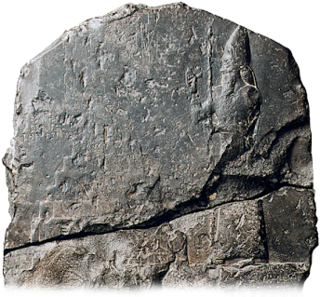
Nebuchadnezzar II, also spelled Nebuchadrezzar II, was the second king of the Neo-Babylonian Empire, ruling from the death of his father Nabopolassar in 605 BC to his own death in 562 BC. Historically known as Nebuchadnezzar the Great, he is typically regarded as the empire's greatest king. Nebuchadnezzar remains famous for his military campaigns in the Levant, for his construction projects in his capital, Babylon, including the Hanging Gardens of Babylon, and for the role he plays in Jewish history. Ruling for 43 years, Nebuchadnezzar was the longest-reigning king of the Chaldean dynasty. By the time of his death, he was among the most powerful rulers in the world.
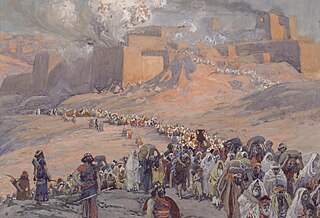
The Babylonian captivity or Babylonian exile is the period in Jewish history during which a large number of Judeans from the ancient Kingdom of Judah were captives in Babylon, the capital city of the Neo-Babylonian Empire, following their defeat in the Jewish–Babylonian War and the destruction of Solomon's Temple in Jerusalem. The event is known to be historical, and is described in the Hebrew Bible in addition to archaeological and extra-biblical sources.
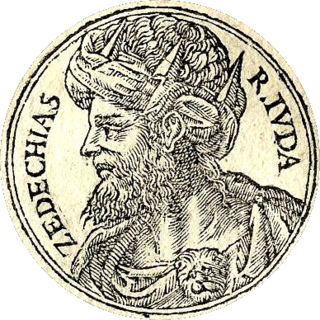
Zedekiah was the twentieth and final King of Judah before the conquest of the kingdom by Nebuchadnezzar II of Babylon. His birth name was Mattaniah/Mattanyahu.

Jeconiah, also known as Coniah and as Jehoiachin, was the nineteenth and penultimate king of Judah who was dethroned by the King of Babylon, Nebuchadnezzar II in the 6th century BCE and was taken into captivity. He was the son and successor of King Jehoiakim, and the grandson of King Josiah. Most of what is known about Jeconiah is found in the Hebrew Bible. Records of Jeconiah's existence have been found in Iraq, such as the Jehoiachin's Rations Tablets. These tablets were excavated near the Ishtar Gate in Babylon and have been dated to c. 592 BCE. Written in cuneiform, they mention Jeconiah and his five sons as recipients of food rations in Babylon.
Gedaliah was a biblical character who was reportedly a governor of Yehud province. He was according to the Bible also the son of Ahikam, who saved prophet Jeremiah.
The Fast of Gedalia (; Hebrew: צוֹם גְּדַלְיָה Tzom Gedalya), also transliterated from the Hebrew language as Gedaliah or Gedalya(h), is a minor Jewish fast day from dawn until dusk to lament the assassination of Gedaliah, the righteous governor of what was the Kingdom of Judah. His death ended Jewish autonomy following the destruction of the First Temple and the fall of King Zedekiah.

The Kings of Judah were the monarchs who ruled over the ancient Kingdom of Judah. According to the biblical account, this kingdom was founded after the death of Saul, when the tribe of Judah elevated David to rule over it. After seven years, David became king of a reunited Kingdom of Israel. However, in about 930 BCE the united kingdom split, with ten of the twelve Tribes of Israel rejecting Solomon's son Rehoboam as their king. The tribes of Judah and Benjamin remained loyal to Rehoboam, and re-formed the Kingdom of Judah, while the other entity continued to be called the Kingdom of Israel, or just Israel.

The Siege of Jerusalem was the final event of the Judahite revolts against Babylon, in which Nebuchadnezzar II, king of the Neo-Babylonian Empire, besieged Jerusalem, the capital city of the Kingdom of Judah. Jerusalem fell after a 30-month siege, following which the Babylonians systematically destroyed the city and the First Temple. The Kingdom of Judah was dissolved and many of its inhabitants were exiled to Babylon.

The return to Zion is an event recorded in Ezra–Nehemiah of the Hebrew Bible, in which the Jews of the Kingdom of Judah—subjugated by the Neo-Babylonian Empire—were freed from the Babylonian captivity following the Persian conquest of Babylon. After their release, the Persian king Cyrus the Great issued a proclamation known as the Edict of Cyrus that enabled the freed Jewish populace, exiled from Judah, to return to Jerusalem and the Land of Judah, which had begun to function as a self-governing Jewish province under the Achaemenid Persian Empire.

The siege of Jerusalem was a military campaign carried out by Nebuchadnezzar II, king of the Neo-Babylonian Empire, in which he besieged Jerusalem, then capital of the Kingdom of Judah. The city surrendered, with king Jeconiah of Judah deported to Babylon and replaced by his Babylonian-appointed uncle, Zedekiah. The siege was recorded by both the Hebrew Bible and the Babylonian Nebuchadnezzar Chronicle.
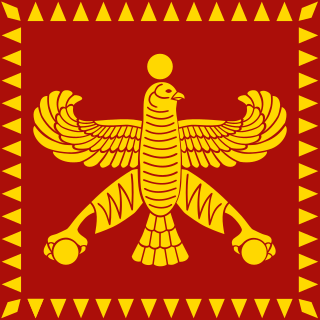
Yehud, also known as Yehud Medinata or Yehud Medinta, was an autonomous administrative province of the Achaemenid Persian Empire. It was one of several such provinces in Palestine, with the others being Moab, Ammon, Gilead, Samaria, Ashdod and Idumea, constituting the fifth Persian satrapy of Eber-Nari. Located in Judea, it continued to exist for two centuries before it was incorporated into the Hellenistic empires following the Wars of Alexander the Great.
IshmaelbenNethaniah was a member of the royal household of Judah who, according to biblical accounts in II Kings and Jeremiah, assassinated Gedaliah after he was appointed governor of Judah by king Nebuchadnezzar of Babylon. The biblical accounts suggest that Ishmael ben Nethaniah's actions were a key factor in the subsequent flight of the people of Judah to Egypt, something Jeremiah counsels strongly against. Nonetheless, the people, led by Johanan son of Kareah, ignore his advice and depart for Egypt.
Jaazaniah or Jezaniah is a biblical Hebrew personal name that appears in the Bible for several different individuals, and has been found on an onyx seal dating from the 6th century BCE.
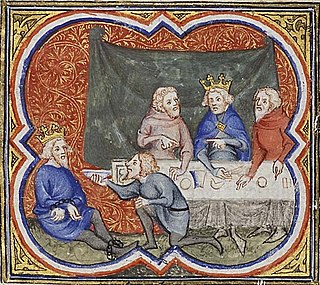
Judah's revolts against Babylon were attempts by the Kingdom of Judah to escape dominance by the Neo-Babylonian Empire. Resulting in a Babylonian victory and the destruction of the Kingdom of Judah, it marked the beginning of the prolonged hiatus in Jewish self-rule in Judaea until the Maccabean Revolt of the 2nd century BCE. Babylonian forces captured the capital city of Jerusalem and destroyed Solomon's Temple, completing the fall of Judah, an event which marked the beginning of the Babylonian captivity, a period in Jewish history in which a large number of Judeans were forcibly removed from Judah and resettled in Mesopotamia.

2 Kings 24 is the twenty-fourth chapter of the second part of the Books of Kings in the Hebrew Bible or the Second Book of Kings in the Old Testament of the Christian Bible. The book is a compilation of various annals recording the acts of the kings of Israel and Judah by a Deuteronomic compiler in the seventh century BCE, with a supplement added in the sixth century BCE. This chapter records the events during the reigns of Jehoiakim, Jehoiachin and Zedekiah, kings of Judah.

2 Chronicles 36 is the thirty-sixth chapter of the Second Book of Chronicles the Old Testament of the Christian Bible or of the second part of the Books of Chronicles in the Hebrew Bible. The book is compiled from older sources by an unknown person or group, designated by modern scholars as "the Chronicler", and had the final shape established in late fifth or fourth century BCE. This chapter belongs to the section focusing on the kingdom of Judah until its destruction by the Babylonians under Nebuchadnezzar and the beginning of restoration under Cyrus the Great of Persia. It contains the regnal accounts of the last four kings of Judah - Jehoahaz, Jehoiakim, Jehoiachin and Zedekiah - and the edict of Cyrus allowing the exiled Jews to return to Jerusalem.

Jeremiah 39 is the thirty-ninth chapter of the Book of Jeremiah in the Hebrew Bible or the Old Testament of the Christian Bible. It is numbered as Jeremiah 46 in the Septuagint. This book contains prophecies attributed to the prophet Jeremiah, and is one of the Books of the Prophets. This chapter is part of a narrative section consisting of chapters 37 to 44. Chapter 39 records the fall of Jerusalem, verses 1–10, and Jeremiah's fate, verses 11–18.

2 Kings 25 is the twenty-fifth and final chapter of the second part of the Books of Kings in the Hebrew Bible or the Second Book of Kings in the Old Testament of the Christian Bible. The book is a compilation of recorded acts of the kings of Israel and Judah by a Deuteronomic compiler in the seventh century BCE; a supplement was added in the sixth century BCE. This chapter records the events during the reign of Zedekiah, the last king of Judah, the fall of Jerusalem, the governorship of Gedaliah, and the release of Jehoiachin from prison in Babylon.















